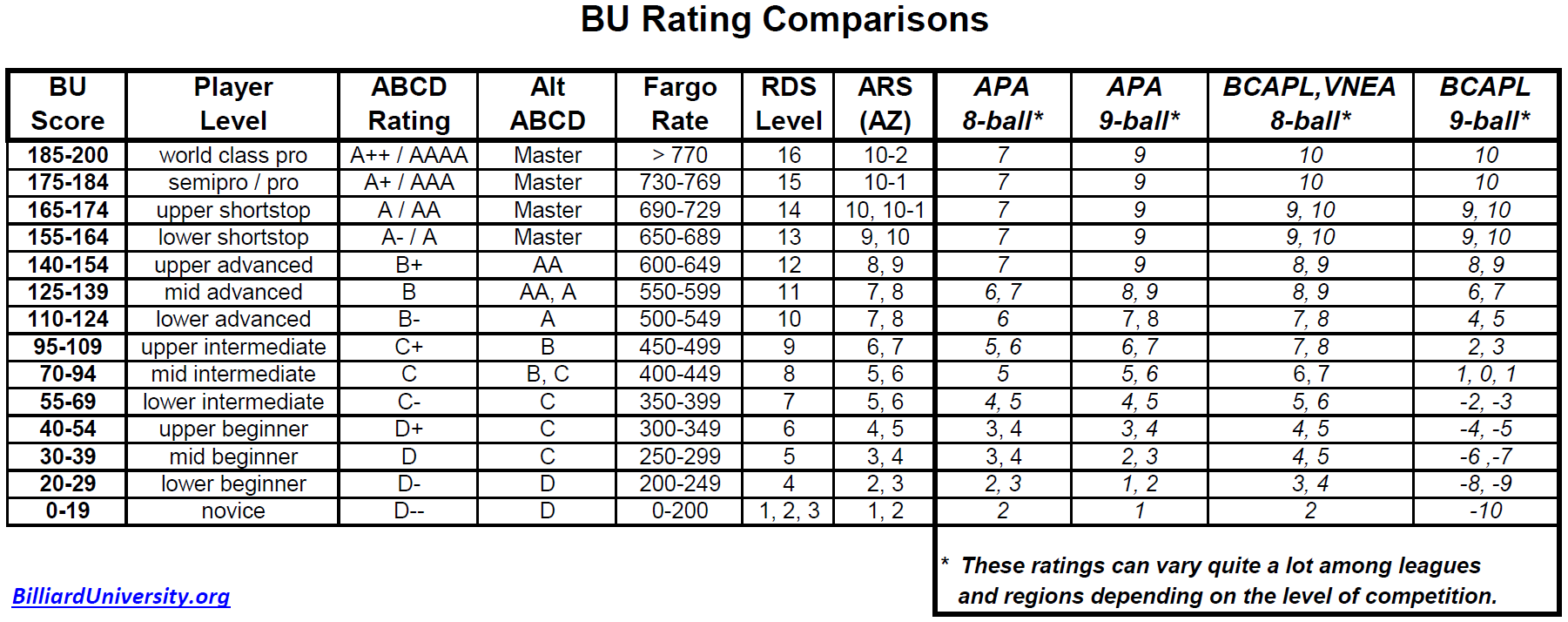How does the 1-10 rating system developed in Arizona work and compare to other ratings?
Here’s how the Arizona Rating System (ARS) compares to typical National ABCD ratings:
AZ Nat. Description
10-2 A+ Top professional. World class player. Capable of winning major professional tournaments. Almost always finishes in the money in any tournament entered.
10-1 A Professional, or player possessing professional skills. Capable of winning local open tournaments. Usually finishes in the money in regional tournaments.
10 A- Semi-pro, or player possessing professional skills. Capable of winning or placing high in the money in local open tournaments.
9 B+ Advanced. Very good position play, strategy and consistency. Top league player. Consistent competitor in local open tournaments.
8 B Advanced. Good position play, strategy and consistency. Good league player. Competitive in local open tournaments.
7 B- Intermediate. Fair amount of knowledge and experience, but inconsistent in execution. Average league player.
6 C+ Intermediate. Has learned quite a few shots, but has a lot to learn about position play and strategy. Inconsistent.
5 C Novice. Has a grasp of the fundamentals, but does not know much about the physics of the game. Lower-level league player.
4 C- Novice. Very basic knowledge of the fundamentals. Knows almost nothing about position play. Lowest-level tournament player.
3 D+ Novice. Knows little about the fundamentals, but might know a couple of shots. Average social player.
2 D Novice. May not know anything about the fundamentals or making shots. Non-competitive.
1 D- Novice. Knows nothing about the game except maybe a few rules of play.
A better system for determining and monitoring a player’s level of ability is the FargoRate rating and handicapping system. If you don’t have a FargoRating, you can approximate your rating with playing-ability tests like the Runout Drill System (RDS) or the Billiard University (BU) Playing Ability Exams. They assess a wide range of important pool skills in a methodical, thorough, and consistent way. They also provide a numeric and descriptive rating. The BU rating comparison chart shows how the BU rating correlates to other commonly used rating and handicapping systems, including the 1-10 ARS system:

from Marty Jones (in Facebook post):
[ARS] matches were a “race to rating”, and they didn’t want to extend races beyond 10. So if you were a 10-2, you raced to 10 and your opponent (if 10 or lower) went to his rating minus 2. If a 10-2 played a 10-1, it was a 10-9 race.
from Mike Page (in Facebook post):
The Arizona Rating System is a thing of the past. It was really a phenomenal effort that involved quarterly meetings of a committee of a few dozen respected room owners/tournament directors/league operators. The following is from the official announcement by the committee chair of its disbanding (December 2018):
“…..It is also a time to be proud and happy. Proud of the job we did and happy that we are handing the mantle over to a system that has the same goal as the ARC. FargoRate is a worldwide billiards rating system that objectively assigns a numerical rating to players based on their actual win/loss records against other rated players. Just as with ARC ratings, Tournament Directors can use these ratings to establish handicaps or entry limitations for their events.
Arizona was one of the early adopter states for the FargoRate system and I feel we are now well integrated in all the machinations. …”
Dr. Dave keeps this site commercial free, with no ads. If you appreciate the free resources, please consider making a one-time or monthly donation to show your support:
